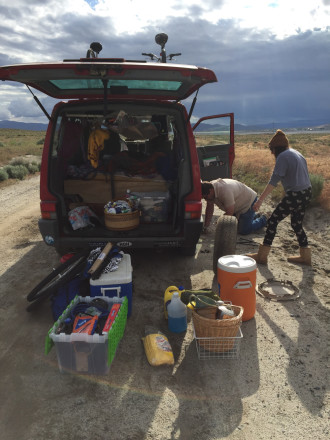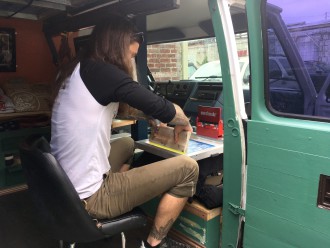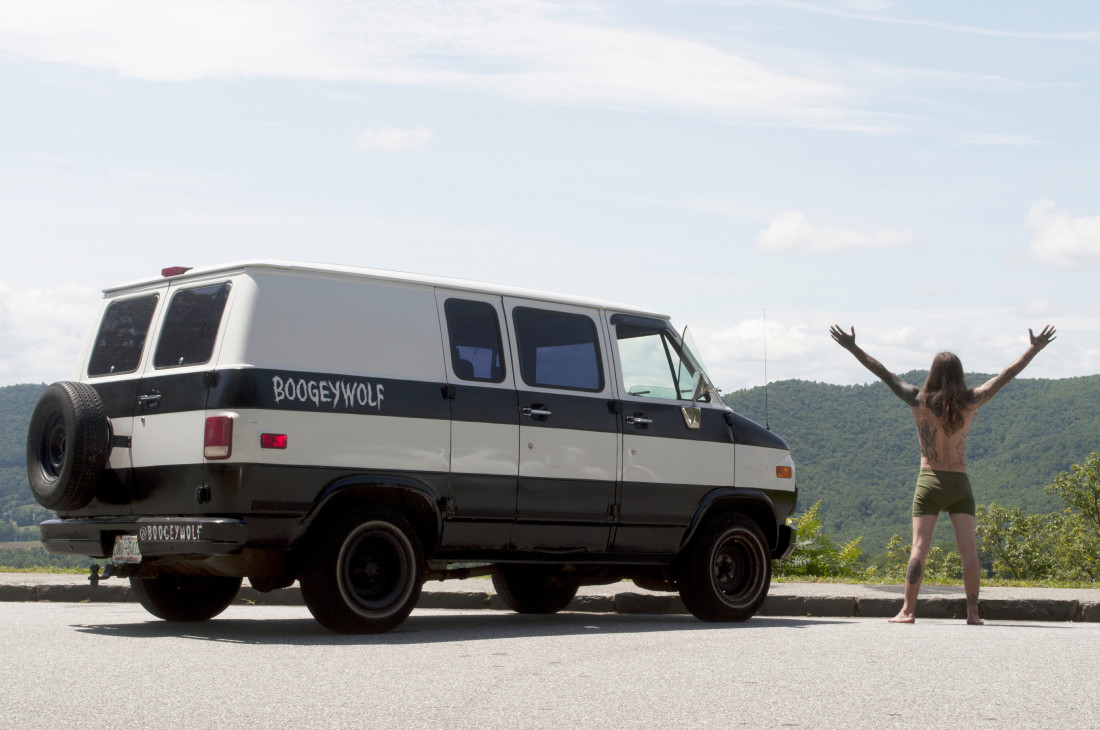“Your van’s on fire!” I heard someone shout outside. Wearing only one shoe, I ran out of the warehouse in Fairview to find my 1977 Volkswagen Westfalia engulfed in flames.
I had just arrived and was celebrating my van’s first successful trip since I’d replaced the engine: For once, it hadn’t had to be towed to my destination.
It was the beginning of January, and the new year had dropped a blanket of snow over the Blue Ridge Mountains. I’d been thawing my toes before a wood stove because the van had no heater.
But there was no time to appreciate the irony or even grab my other shoe. With my bare hands, I frantically shoveled snow onto the flames bursting out of the engine compartment. Someone ran outside with a fire extinguisher, but it was a dud. He went back in and came out with another one that didn’t work either. Six inoperative fire extinguishers later, any hope of saving my ride — not to mention my home — was kaput.
The flames had literally consumed everything I owned, turning a splashy hippie bus into a kind of cremation chamber. Asheville’s a funny place, and the trip here had left me with nothing but ashes. Yet that’s when my van life really began — and as it turned out, I was far from alone.
Winging it
Andrea Luna and Mary Beth Desjardins sip their drinks on the patio at Edna’s, carrying on a seemingly normal discussion of their business plans while a Catalina macaw rests peacefully on Luna’s shoulder and a pigeon sits on Desjardins’ leg. Customers and passers-by at the Merrimon Avenue coffeehouse do a double take, wanting to make sure they’re indeed seeing two beautiful birds perched on two attractive women.
These artists are brainstorming ways to make traveling — as often and as far as possible — a top priority in their lives. The goal, they say, is to figure out how to make a living without the geographical constraints a conventional career often entails. For now, however, “The Bird Girls” (as they’re known around town) have set up a temporary home base in Asheville. They recently bought an old school bus that they intend to turn into a mobile living and working space in support of their new life as “The Lunar Ladybirds.”
“We like it here,” says Luna, praising the area’s creative vibe, vibrant arts districts and one-of-a-kind characters.
Elsewhere in town, “Mr. Wolf,” as he prefers to be called, is living and working out of his van. He visited Asheville four years ago, and it made such an impression that he decided to move here from Maine a year later. It was partly to escape the seasonal affective disorder he’d experienced during the long New England winters. But for a van-lifer, the Blue Ridge Parkway also proved to be a draw, he says. “It’s a wonderful thing to wake up and stand in your underwear overlooking the mountains.”
The call of the road
In Asheville, Mr. Wolf got a job in a bar downtown, found a place to stay and saved up $1,500 to buy a 1995 Chevrolet G10 van. He spent another $3,500 converting it into a camper/mobile work studio and “started a T-shirt company out of my van.” Living the van life in Asheville isn’t hard, he reports. “If you can’t get a secure place downtown, or are told to move along, some larger businesses allow parking overnight.” And at least for the time being, Mr. Wolf’s day job is keeping him here.

But for many if not most van-lifers, freedom and autonomy are the primary attractions.
Two and a half years ago, Melody DeGroat and Lindsay Yodice were working in New York City’s fashion industry and felt they’d hit a wall in their careers. “I was not finding happiness in something I was spending most of my days doing,” DeGroat reveals. The lifelong friends decided they needed something more fulfilling, and they chose van life.
For them, volunteering loomed large in the equation. “Growing up, we always volunteered,” says DeGroat. Now, these two women travel around in a 1993 Volkswagen EuroVan named Scarlet and volunteer in every town they stop in.
The “Gypsy Givers,” as they style themselves, passed through the area early on. “We loved Asheville. It was one of our first stops, and it definitely struck a chord with us,” DeGroat recalls. But while she and her traveling partner felt this was a town they could settle down in, the call of the road proved stronger, and they “had to keep moving.”
More recently, the two were in Asia, though they had to leave the van behind. They volunteered at an elephant sanctuary and organized their own beach cleanup along the coast of Vietnam. In the United States, they’re long-standing participants in the Volunteers of America’s Fresh Food Factor program and have volunteered with the Special Olympics, Habitat for Humanity, animal rescues and tons of food pantries.
“There’s always a food pantry, and they always need extra hands,” notes Yodice.
Looking past the hashtag
Search for #vanlife on Instagram, and you’ll be flooded with countless images of vans parked amid captivating landscapes, often with a beautiful girl in a bikini alongside. But you won’t find many accurate depictions of what van life actually entails.
Expand your search to other social media platforms such as Medium, Twitter and Reddit, and you’ll find vans being renovated into mobile tiny homes, van-lifers sharing posts about the trials of living in a vehicle, how-to guides for newbies and tips on how to work around the host of challenges that come with the territory.
In a recent article in The New Yorker, Rachel Monroe wrote about the several days she spent with Emily King and Corey Smith, a couple who live out of their Volkswagen van. The article, though, chose to focus on what it called “influencer marketing,” explaining how the couple make money off their Instagram account, “Where’s My Office Now?” In a subsequent Marketplace radio interview, Monroe described van life as “a hashtag that spawned a movement that is increasingly popular on Instagram” and is “most basically people who live in vans and take pictures of themselves living in vans.”

But the #vanlife hashtag doesn’t tell the truth about the lifestyle, any more than #newyorker really tells you what it’s like to live in the Big Apple. For many van-lifers, the hashtag is simply a way to document their journeys and make connections with their fellow van dwellers. For a select few, it’s a way to appeal to advertisers — much like publishing a magazine.
In a written response to the New Yorker piece, King questioned why the story had placed so much emphasis “on the financial aspect of van life and especially influencer marketing. … And why the friction?” A frustrated King explained, “We live in a van because we love it. Plus, our lifestyle of movement has helped us reclaim real wealth.” In her view, she continued, real wealth includes working with purpose, engaging with nature, pushing your limits and following your passion.
Money for nothin’
Influencer marketing, which involves product placement and partnerships with brands, is a fancy new term that roughly corresponds to sponsored content, except that “influencers” exist on social media platforms rather than in news magazines.
“One study estimated that the social-media-influencer market was worth $500 million in 2015; the market is expected to increase to at least $5 billion by 2020,” The New Yorker noted. But that’s small change compared with the kind of advertising revenue generated by traditional publications. A recent piece by the CEO of Polar, a branded content company, estimates that this year, the top 5,000 publishers will generate $6 billion in digital revenue from sponsored content. “The market is growing at 35 percent and will reach $20 billion by 2021,” he predicted.
In her Marketplace interview, Monroe, the New Yorker writer, said she couldn’t live the van life because practitioners “spend hours on every single Instagram post,” pointing out that “they have to edit it, they have to negotiate with the sponsors what it’s going to look like, what the caption is going to say. There’s just so much work that goes into looking effortless.”
But journalists typically spend days or weeks on the articles they write. Once a story is submitted, it may get reviewed by multiple editors, triggering rewrites, requests for headline ideas and the need to find the perfect photo to illustrate the text.
And however lucrative the outside world may think being a professional social media influencer is, for most van-lifers out on the road, freelance work remains their primary way to generate revenue.
The Gypsy Givers, for example, spent 14 months planning and saving money before starting their van-life journey, yet they now survive by working remote freelance gigs. “We’re working whenever we can,” notes DeGroat, adding, “If you have the time and the management and the willpower to do it, you can make your dreams come true.”
The Lunar Ladybirds, meanwhile, are still in the planning stage. They hope to make a living selling art: clothing, jewelry and what they call “tag-team face paintings.” They also have a handful of other, mostly entertainment-based ideas, including fire-art performances. “I’ve been dreaming this dream for years now,” says Luna, “to get the art out there.”
At the moment, though, the Ladybirds’ main draw remains their exotic birds. Luna says her macaw has helped her “stand out in the art world,” enabling her to reach a broader audience.
But with their expanding plans came a need for more space, which inspired the pair to buy the bus. “We’re acquiring a circus,” Desjardins reports.
The real deal
Long before Instagram came along, Chris Stivers spent a decade living in his Volkswagen van. Stivers, who now owns the Asheville Vee Dub repair shop in Fairview, says the biggest attraction to his former life was his love of the outdoors. From 1991 to 2001, he traveled across the country, following bands like the Grateful Dead and making most of his money vending at festivals.
His 1970 VW Westfalia, Stivers recalls, had a “rinky-dink” 60-horsepower engine that struggled to make it up hills. Van-lifers today, he maintains, have it easy, with their smartphones and an internet archive of info on how to fix almost every mechanical problem. He remembers having to scour the Yellow Pages for a parts store and then spend weeks waiting for the part to arrive. These days, a Google search can quickly find you what you need to get back on the road in a matter of hours or days.
Perhaps not surprisingly, Stivers takes a dim view of professional van-lifers who seek to profit off a watered-down version of the lifestyle.
But they’re the exceptions. Through his VW repair work and his own travels, Stivers says he’s met folks from all over the world who genuinely exemplified the spirit of mobile living. He describes one customer, a woman from Oregon who drives a 1964 VW bus, as “a real van-lifer. She’s been doing it since the late ’60s, I’m sure. She still has the same van she bought back then.”
Anyone who’s done due diligence will find that van life overlaps with other so-called “movements,” such as what are called “digital nomads” — folks who put having a Wi-Fi connection at the top of their list, with traveling ranked second. These people have no interest in settling down, preferring to build a life based on remote work and travel. And unlike the idea of living in your van, this lifestyle is indeed a recent trend.
But for van-lifers who, like Mr. Wolf, choose to stay in one place, living out of their van is also a practical matter. As one Reddit user put it, “Best thing about waking up in a van is not waking up in an apartment that costs $1,500 a month.”
In San Francisco and the Pacific Northwest, Stivers says he saw a lot of van dwellers who’d stay put for extended periods. “You’d see an old van on the street, and it’d have curtains in it, and you’d see a light on.”
The smell test
The New Yorker article characterized van life as “millennials living out a leftover baby-boomer fantasy: the Volkswagens, the neo-hippie fashions, the retro gender dynamics,” calling it a “trend born out of the recent recession.”
Unquestionably, van life is a product of practical economics. But people have been living out of vans as long as there’ve been vans. And whether they’re digital nomads, artists, surfers, rock climbers or other outdoors enthusiasts, van-lifers view it as a means to an end: being able to do what they love every day. Still, whatever that passion may be, the realities of road life are guaranteed to strip away the glitter.
In 2013, Alexander Haro, a senior editor for The Inertia (an online publication about outdoor culture), penned a provocative and harrowing tale about his experiences living in his van. “I’m a sucker for those gossamer-tipped dreams that the surf industry pukes out,” he wrote. “I want them so much that I convince myself that they’re realistic. And when I try and re-create them, I find that beneath those gossamer tips lies a layer of dirt.” But while Haro cautioned readers inclined to give van life a go to “be prepared for a sudden realization that it’s probably not the beautiful thing you thought it was,” he went on to explain that “It IS beautiful, just a different kind of beauty. A dirtier, grittier kind; one that smells much worse.”
Making it work
According to the New Yorker article, this lifestyle is appealing “because it’s cheap and because they don’t have a lot of options for settling down and building a solid life.”
For many, however, the real appeal is that it offers a practical and affordable way to travel. “That’s the way you got to do it if you don’t have much money,” says Stivers. “Just puttin’ around.”
Van life has the added benefit of bringing together unlikely characters with wildly differing perspectives. Last summer, for example, I found myself crashing on the couch of an armed Trump supporter who’d offered to teach me how to rebuild my busted engine. The idea of a traveling “hippie” with a VW van and a die-hard Trump supporter coexisting under one roof might seem absurd, but that’s what happened: Two people with diametrically opposed ideals wound up working together. And ultimately, that’s a big part of what van life is about: getting out of your comfort zone and making things happen.
In my experience, the folks who live this lifestyle are no different from those who choose to pursue the traditional American dream with a location-based career, a mortgage and marriage with kids. We’ve just traded mundane small talk about the fastest morning commutes for mundane small talk about the times we were stuck on the side of the road.
And in any case, not everyone who opts for a less conventional, more mobile lifestyle achieves the freedom that they dream of.
“Back when I was traveling,” says Stivers, “I saw a lot of people with money that were traveling too, but they didn’t learn how to be really free because they weren’t totally independent of needing all that money. That money is going to keep you from learning how to do without. I would think, if you don’t have the means monetarily, you’ll figure it out.”





The first time I heard someone from Asheville call in to “Car Talk” was from a group who had trekked here across the country in a VW van only to have it break down at a local campsite.
Hi David, enjoyed your article. I was surprised you didn’t mention the Van Life Rally (https://www.ashevillevanlife.com) happening here in Asheville at the Wedge on September 28th. Lots of Van Lifers and adventure vehicles will be there.
Enjoyed the article and was very sorry to see your van going up in flames. Living a van life definitely helps give you a different perspective on things and make traveling more affordable. Our travels can be found at oldmassrambler.com. However I would disagree that having some money precludes you from finding true freedom. Having cash in your pocket gives you options.